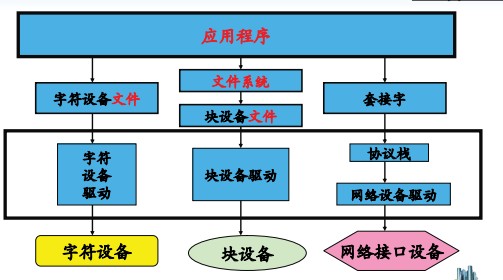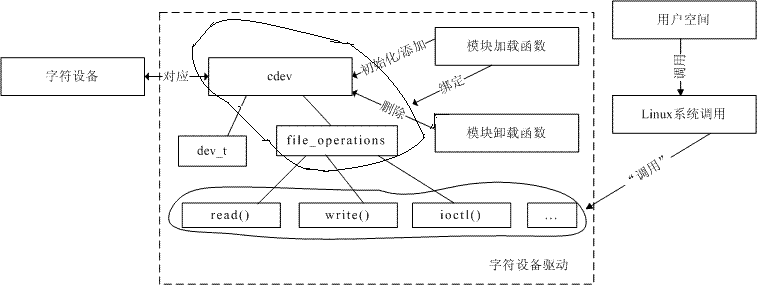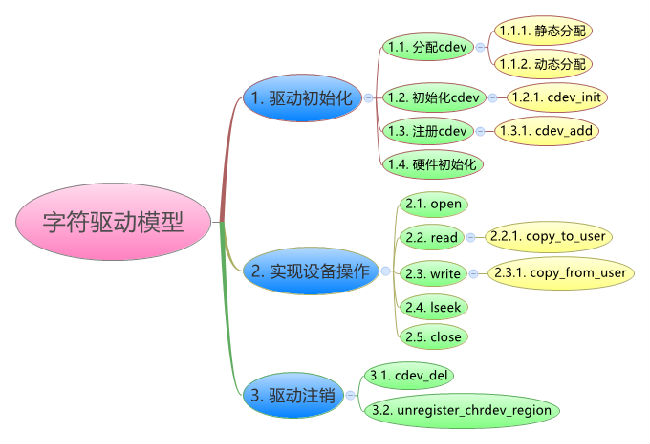一、linux系統將裝置分為3類:字元裝置、塊裝置、網路裝置。使用驅動程式:

- 字元裝置:是指只能一個位元組一個位元組讀寫的裝置,不能隨機讀取裝置記憶體中的某一資料,讀取資料需要按照先後資料。字元裝置是面向流的裝置,常見的字元裝置有滑鼠、鍵盤、串列埠、控制檯和LED裝置等。
- 塊裝置:是指可以從裝置的任意位置讀取一定長度資料的裝置。塊裝置包括硬碟、磁碟、U盤和SD卡等。
每一個字元裝置或塊裝置都在/dev目錄下對應一個裝置檔案。linux使用者程式通過裝置檔案(或稱裝置節點)來使用驅動程式操作字元裝置和塊裝置。
二、字元裝置、字元裝置驅動與使用者空間訪問該裝置的程式三者之間的關係。

如圖,在Linux核心中使用cdev結構體來描述字元裝置,通過其成員dev_t來定義裝置號(分為主、次裝置號)以確定字元裝置的唯一性。通過其成員file_operations來定義字元裝置驅動提供給VFS的介面函式,如常見的open()、read()、write()等。
在Linux字元裝置驅動中,模組載入函式通過register_chrdev_region( ) 或alloc_chrdev_region( )來靜態或者動態獲取裝置號,通過cdev_init( )建立cdev與file_operations之間的連線,通過cdev_add( )向系統新增一個cdev以完成註冊。模組解除安裝函式通過cdev_del( )來登出cdev,通過unregister_chrdev_region( )來釋放裝置號。
使用者空間訪問該裝置的程式通過Linux系統呼叫,如open( )、read( )、write( ),來“呼叫”file_operations來定義字元裝置驅動提供給VFS的介面函式。
三、字元裝置驅動模型

1. 驅動初始化
1.1. 分配cdev
在2.6的核心中使用cdev結構體來描述字元裝置,在驅動中分配cdev,主要是分配一個cdev結構體與申請裝置號,以按鍵驅動為例:


1 /*……*/ 2 /* 分配cdev*/ 3 struct cdev btn_cdev; 4 /*……*/ 5 /* 1.1 申請裝置號*/ 6 if(major){ 7 //靜態 8 dev_id = MKDEV(major, 0); 9 register_chrdev_region(dev_id, 1, "button"); 10 } else { 11 //動態 12 alloc_chardev_region(&dev_id, 0, 1, "button"); 13 major = MAJOR(dev_id); 14 } 15 /*……*/
從上面的程式碼可以看出,申請裝置號有動靜之分,其實裝置號還有主次之分。
在Linux中以主裝置號用來標識與裝置檔案相連的驅動程式。次編號被驅動程式用來辨別操作的是哪個裝置。cdev 結構體的 dev_t 成員定義了裝置號,為 32 位,其中高 12 位為主裝置號,低20 位為次裝置號。
裝置號的獲得與生成:
獲得:主裝置號:MAJOR(dev_t dev);
次裝置號:MINOR(dev_t dev);
生成:MKDEV(int major,int minor);
裝置號申請的動靜之分:
靜態:
1 int register_chrdev_region(dev_t from, unsigned count, const char *name); 2 /*功能:申請使用從from開始的count 個裝置號(主裝置號不變,次裝置號增加)*/
靜態申請相對較簡單,但是一旦驅動被廣泛使用,這個隨機選定的主裝置號可能會導致裝置號衝突,而使驅動程式無法註冊。
動態:
1 int alloc_chrdev_region(dev_t *dev, unsigned baseminor, unsigned count,const char *name); 2 /*功能:請求核心動態分配count個裝置號,且次裝置號從baseminor開始。*/
動態申請簡單,易於驅動推廣,但是無法在安裝驅動前建立裝置檔案(因為安裝前還沒有分配到主裝置號)。
1.2. 初始化cdev
1 void cdev_init(struct cdev *, struct file_operations *); 2 cdev_init()函式用於初始化 cdev 的成員,並建立 cdev 和 file_operations 之間的連線。
1.3. 註冊cdev
1 int cdev_add(struct cdev *, dev_t, unsigned);
2 cdev_add()函式向系統新增一個 cdev,完成字元裝置的註冊。
1.4. 硬體初始化
硬體初始化主要是硬體資源的申請與配置,以TQ210的按鍵驅動為例:
1 /* 1.4 硬體初始化*/ 2 //申請GPIO資源 3 gpio_request(S5PV210_GPH0(0), "GPH0_0"); 4 //配置輸入 5 gpio_direction_input(S5PV210_GPH0(0));
2.實現裝置操作
使用者空間的程式以訪問檔案的形式訪問字元裝置,通常進行open、read、write、close等系統呼叫。而這些系統呼叫的最終落實則是file_operations結構體中成員函式,它們是字元裝置驅動與核心的介面。以TQ210的按鍵驅動為例:
1 /*裝置操作集合*/ 2 static struct file_operations btn_fops = { 3 .owner = THIS_MODULE, 4 .open = button_open, 5 .release = button_close, 6 .read = button_read 7 };
上面程式碼中的button_open、button_close、button_read是要在驅動中自己實現的。file_operations結構體成員函式有很多個,下面就選幾個常見的來展示:
2.1. open()函式
原型:
1 int(*open)(struct inode *, struct file*); 2 /*開啟*/
2.2. read( )函式
原型:
ssize_t(*read)(struct file *, char __user*, size_t, loff_t*); /*用來從裝置中讀取資料,成功時函式返回讀取的位元組數,出錯時返回一個負值*/
2.3. write( )函式
原型:
1 ssize_t(*write)(struct file *, const char__user *, size_t, loff_t*); 2 /*向裝置傳送資料,成功時該函式返回寫入的位元組數。如果此函式未被實現, 3 當使用者進行write()系統呼叫時,將得到-EINVAL返回值*/
2.4. close( )函式
原型:
1 int(*release)(struct inode *, struct file*); 2 /*關閉*/
2.5. 補充說明
1. 在Linux字元裝置驅動程式設計中,有3種非常重要的資料結構:struct file、struct inode、struct file_operations。
struct file 代表一個開啟的檔案。系統中每個開啟的檔案在核心空間都有一個關聯的struct file。它由核心在開啟檔案時建立, 在檔案關閉後釋放。其成員loff_t f_pos 表示檔案讀寫位置。
struct inode 用來記錄檔案的物理上的資訊。因此,它和代表開啟檔案的file結構是不同的。一個檔案可以對應多個file結構,但只有一個inode結構。其成員dev_t i_rdev表示裝置號。
struct file_operations 一個函式指標的集合,定義能在裝置上進行的操作。結構中的成員指向驅動中的函式,這些函式實現一個特別的操作, 對於不支援的操作保留為NULL。
2. 在read( )和write( )中的buff 引數是使用者空間指標。因此,它不能被核心程式碼直接引用,因為使用者空間指標在核心空間時可能根本是無效的——沒有那個地址的對映。因此,核心提供了專門的函式用於訪問使用者空間的指標:
1 unsigned long copy_from_user(void *to, const void __user *from, unsigned long count); 2 unsigned long copy_to_user(void __user *to, const void *from, unsigned long count);
3. 驅動登出
3.1. 刪除cdev
在字元裝置驅動模組解除安裝函式中通過cdev_del()函式向系統刪除一個cdev,完成字元裝置的登出。
/*原型:*/
void cdev_del(struct cdev *);
/*例:*/
cdev_del(&btn_cdev); 3.2. 釋放裝置號
在呼叫cdev_del()函式從系統登出字元裝置之後,unregister_chrdev_region()應該被呼叫以釋放原先申請的裝置號。
/*原型:*/
void unregister_chrdev_region(dev_t from, unsigned count);
/*例:*/
unregister_chrdev_region(MKDEV(major, 0), 1);
四、字元裝置驅動程式基礎:
4.1 cdev結構體
在Linux2.6 核心中,使用cdev結構體來描述一個字元裝置,cdev結構體的定義如下:


1 struct cdev { 2 3 struct kobject kobj; 4 5 struct module *owner; /*通常為THIS_MODULE*/ 6 7 struct file_operations *ops; /*在cdev_init()這個函式裡面與cdev結構聯絡起來*/ 8 9 struct list_head list; 10 11 dev_t dev; /*裝置號*/ 12 13 unsigned int count; 14 15 };
cdev 結構體的dev_t 成員定義了裝置號,為32位,其中12位是主裝置號,20位是次裝置號,我們只需使用二個簡單的巨集就可以從dev_t 中獲取主裝置號和次裝置號:
MAJOR(dev_t dev)
MINOR(dev_t dev)
相反地,可以通過主次裝置號來生成dev_t:
MKDEV(int major,int minor)
4.2 Linux 2.6核心提供一組函式用於操作cdev 結構體:


1:void cdev_init(struct cdev*,struct file_operations *); 2:struct cdev *cdev_alloc(void); 3:int cdev_add(struct cdev *,dev_t,unsigned); 4:void cdev_del(struct cdev *);
其中(1)用於初始化cdev結構體,並建立cdev與file_operations 之間的連線。(2)用於動態分配一個cdev結構,(3)向核心註冊一個cdev結構,(4)向核心登出一個cdev結構
4.3 Linux 2.6核心分配和釋放裝置號
在呼叫cdev_add()函式向系統註冊字元裝置之前,首先應向系統申請裝置號,有二種方法申請裝置號,一種是靜態申請裝置號:
5:int register_chrdev_region(dev_t from,unsigned count,const char *name)
另一種是動態申請裝置號:
6:int alloc_chrdev_region(dev_t *dev,unsigned baseminor,unsigned count,const char *name);
其中,靜態申請是已知起始裝置號的情況,如先使用cat /proc/devices 命令查得哪個裝置號未事先使用(不推薦使用靜態申請);動態申請是由系統自動分配,只需設定major = 0即可。
相反地,在呼叫cdev_del()函式從系統中登出字元裝置之後,應該向系統申請釋放原先申請的裝置號,使用:
7:void unregister_chrdev_region(dev_t from,unsigned count);
4.4 cdev結構的file_operations結構體
這個結構體是字元裝置當中最重要的結構體之一,file_operations 結構體中的成員函式指標是字元裝置驅動程式設計的主體內容,這些函式實際上在應用程式進行Linux 的 open()、read()、write()、close()、seek()、ioctl()等系統呼叫時最終被呼叫。


1 struct file_operations { 2 3 /*擁有該結構的模組計數,一般為THIS_MODULE*/ 4 struct module *owner; 5 6 /*用於修改檔案當前的讀寫位置*/ 7 loff_t (*llseek) (struct file *, loff_t, int); 8 9 /*從裝置中同步讀取資料*/ 10 ssize_t (*read) (struct file *, char __user *, size_t, loff_t *); 11 12 /*向裝置中寫資料*/ 13 ssize_t (*write) (struct file *, const char __user *, size_t, loff_t *); 14 15 16 ssize_t (*aio_read) (struct kiocb *, const struct iovec *, unsigned long, loff_t); 17 ssize_t (*aio_write) (struct kiocb *, const struct iovec *, unsigned long, loff_t); 18 int (*readdir) (struct file *, void *, filldir_t); 19 20 /*輪詢函式,判斷目前是否可以進行非阻塞的讀取或寫入*/ 21 unsigned int (*poll) (struct file *, struct poll_table_struct *); 22 23 /*執行裝置的I/O命令*/ 24 int (*ioctl) (struct inode *, struct file *, unsigned int, unsigned long); 25 26 27 long (*unlocked_ioctl) (struct file *, unsigned int, unsigned long); 28 long (*compat_ioctl) (struct file *, unsigned int, unsigned long); 29 30 /*用於請求將裝置記憶體對映到程式地址空間*/ 31 int (*mmap) (struct file *, struct vm_area_struct *); 32 33 /*開啟裝置檔案*/ 34 int (*open) (struct inode *, struct file *); 35 int (*flush) (struct file *, fl_owner_t id); 36 37 /*關閉裝置檔案*/ 38 int (*release) (struct inode *, struct file *); 39 40 41 int (*fsync) (struct file *, struct dentry *, int datasync); 42 int (*aio_fsync) (struct kiocb *, int datasync); 43 int (*fasync) (int, struct file *, int); 44 int (*lock) (struct file *, int, struct file_lock *); 45 ssize_t (*sendpage) (struct file *, struct page *, int, size_t, loff_t *, int); 46 unsigned long (*get_unmapped_area)(struct file *, unsigned long, unsigned long, unsigned long, unsigned long); 47 int (*check_flags)(int); 48 int (*flock) (struct file *, int, struct file_lock *); 49 ssize_t (*splice_write)(struct pipe_inode_info *, struct file *, loff_t *, size_t, unsigned int); 50 ssize_t (*splice_read)(struct file *, loff_t *, struct pipe_inode_info *, size_t, unsigned int); 51 int (*setlease)(struct file *, long, struct file_lock **); 52 };
4.5 file結構
file 結構代表一個開啟的檔案,它的特點是一個檔案可以對應多個file結構。它由核心再open時建立,並傳遞給在該檔案上操作的所有函式,直到最後close函式,在檔案的所有例項都被關閉之後,核心才釋放這個資料結構。
在核心原始碼中,指向 struct file 的指標通常比稱為filp,file結構有以下幾個重要的成員:


1 struct file{ 2 3 mode_t fmode; /*檔案模式,如FMODE_READ,FMODE_WRITE*/ 4 5 ...... 6 7 loff_t f_pos; /*loff_t 是一個64位的數,需要時,須強制轉換為32位*/ 8 9 unsigned int f_flags; /*檔案標誌,如:O_NONBLOCK*/ 10 11 struct file_operations *f_op; 12 13 void *private_data; /*非常重要,用於存放轉換後的裝置描述結構指標*/ 14 15 ....... 16 17 };
4.6 inode 結構
核心用inode 結構在內部表示檔案,它是實實在在的表示物理硬體上的某一個檔案,且一個檔案僅有一個inode與之對應,同樣它有二個比較重要的成員:


1 struct inode{ 2 3 dev_t i_rdev; /*裝置編號*/ 4 5 struct cdev *i_cdev; /*cdev 是表示字元裝置的核心的內部結構*/ 6 7 }; 8 9 可以從inode中獲取主次裝置號,使用下面二個巨集: 10 11 /*驅動工程師一般不關心這二個巨集*/ 12 13 unsigned int imajor(struct inode *inode); 14 15 unsigned int iminor(struct inode *inode);
4.7字元裝置驅動模組載入與解除安裝函式
在字元裝置驅動模組載入函式中應該實現裝置號的申請和cdev 結構的註冊,而在解除安裝函式中應該實現裝置號的釋放與cdev結構的登出。
我們一般習慣將cdev內嵌到另外一個裝置相關的結構體裡面,該裝置包含所涉及的cdev、私有資料及訊號量等等資訊。常見的裝置結構體、模組載入函式、模組解除安裝函式形式如下:


1 /*裝置結構體*/ 2 3 struct xxx_dev{ 4 5 struct cdev cdev; 6 7 char *data; 8 9 struct semaphore sem; 10 11 ...... 12 13 }; 14 15 16 17 /*模組載入函式*/ 18 19 static int __init xxx_init(void) 20 21 { 22 23 ....... 24 25 初始化cdev結構; 26 27 申請裝置號; 28 29 註冊裝置號; 30 31 32 33 申請分配裝置結構體的記憶體; /*非必須*/ 34 35 } 36 37 38 39 /*模組解除安裝函式*/ 40 41 static void __exit xxx_exit(void) 42 43 { 44 45 ....... 46 47 釋放原先申請的裝置號; 48 49 釋放原先申請的記憶體; 50 51 登出cdev裝置; 52 53 } 54 55
4.8字元裝置驅動的 file_operations 結構體重成員函式


1 /*讀裝置*/ 2 3 ssize_t xxx_read(struct file *filp, char __user *buf, size_t count, loff_t *f_pos) 4 5 { 6 7 ...... 8 9 使用filp->private_data獲取裝置結構體指標; 10 11 分析和獲取有效的長度; 12 13 /*核心空間到使用者空間的資料傳遞*/ 14 15 copy_to_user(void __user *to, const void *from, unsigned long count); 16 17 ...... 18 19 } 20 21 /*寫裝置*/ 22 23 ssize_t xxx_write(struct file *filp, const char __user *buf, size_t count, loff_t *f_pos) 24 25 { 26 27 ...... 28 29 使用filp->private_data獲取裝置結構體指標; 30 31 分析和獲取有效的長度; 32 33 /*使用者空間到核心空間的資料傳遞*/ 34 35 copy_from_user(void *to, const void __user *from, unsigned long count); 36 37 ...... 38 39 } 40 41 /*ioctl函式*/ 42 43 static int xxx_ioctl(struct inode *inode,struct file *filp,unsigned int cmd,unsigned long arg) 44 45 { 46 47 ...... 48 49 switch(cmd){ 50 51 case xxx_CMD1: 52 53 ...... 54 55 break; 56 57 case xxx_CMD2: 58 59 ....... 60 61 break; 62 63 default: 64 65 return -ENOTTY; /*不能支援的命令*/ 66 67 } 68 69 return 0; 70 71 }
4.9、字元裝置驅動檔案操作結構體模板


1 struct file_operations xxx_fops = { 2 3 .owner = THIS_MODULE, 4 5 .open = xxx_open, 6 7 .read = xxx_read, 8 9 .write = xxx_write, 10 11 .close = xxx_release, 12 13 .ioctl = xxx_ioctl, 14 15 .lseek = xxx_llseek, 16 17 }; 18 19 上面的寫法需要注意二點,一:結構體成員之間是以逗號分開的而不是分號,結構體欄位結束時最後應加上分號。
五、字元裝置驅動小結:
字元裝置是3大類裝置(字元裝置、塊裝置、網路裝置)中較簡單的一類裝置,其驅動程式中完成的主要工作是初始化、新增和刪除cdev結構體,申請和釋放裝置號,以及填充file_operation結構體中操作函式,並實現file_operations結構體中的read()、write()、ioctl()等重要函式。如圖所示為cdev結構體、file_operations和使用者空間呼叫驅動的關係。

版權所有,轉載請註明轉載地址:http://www.cnblogs.com/lihuidashen/p/4426129.html